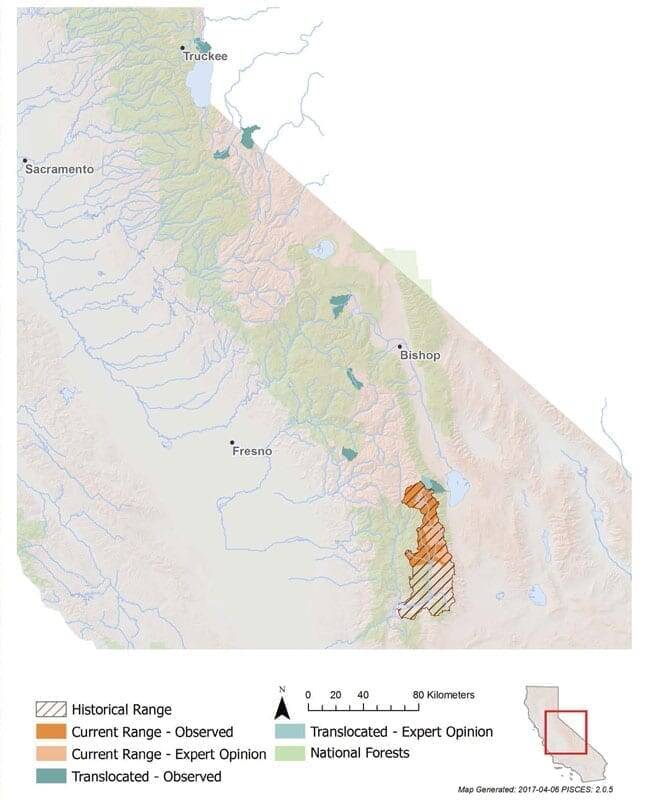Conservation Actions
- Review and update the 2004 Conservation Strategy.
- Implement revised Conservation Strategy to eliminate non-native trout species.
- Monitor and evaluate barrier performance and collect abundance, distribution, and genetic data to determine Strategy efficacy.
- Restrict grazing and off-road vehicles from sensitive areas.
- Protect streams with pure and slightly hybridized California Golden trout as refuge populations.
- Restore degraded headwater meadows to increase cool streamflows in summer and fall months and enhance species resiliency.
Click here to learn about CalTrout’s overall “Return to Resilience” plan to save California’s salmonids from extinction.
Where to find California Golden Trout:
California Golden Trout Distribution
California Golden trout are native to the South Fork Kern River and its tributaries, Golden Trout Creek and Volcano Creek. As a result of extensive pack train collection and stocking efforts over the last century, they can be found in nearby Cottonwood Lakes and Mulkey Creek, as well as several watersheds in the Sierra Nevada. Expanded stocking has introduced them to more than 300 high mountain lakes and 1,100 km (about 680 mi.) of streams outside their native range, including in Utah, Wyoming, and Montana.
How the California Golden Trout Scored:


Characteristics
California Golden trout take their name from their bright, yellow-gold coloration. Their backs are usually copper, with brilliant golden sides and bright red bands on their flanks. Their bellies are often deep red, and even adult fish retain parr marks. They have large spots on their fins and tail, with black bands and white to yellowish tips. They can grow to 19-20 cm (about 8 in.) and reach a maximum age of nine years in streams. They are capable of growing larger in lakes – the largest Golden trout ever caught, in Virginia Lake (Madera County), weighed 4.5 kg (10 lbs.). Their striking appearance makes them easily recognizable, and led to California Golden trout becoming the official State fish of California in 1947.
Abundance
Despite numerous translocations to various watersheds, unhybridized California Golden trout are much less abundant in their native range than they once were. In 1965, an estimated 40,000 California Golden trout inhabited Golden Trout Creek and the South Fork Kern River. At present, only 400-2,600 ‘pure’ California Golden Trout remain in their native habitat in 5 km (about 3 mi.) of Volcano Creek, representing a decrease of 95% from historical numbers.
Habitat & Behavior
California Golden trout live in cold, clear mountain streams in meadows at high elevations over 2,300m (about 7,500 ft.). They prefer to stay in short reaches of streams, such as in pools and beneath undercut banks, for most of their lives. Most of their habitat is made up of riparian meadows in the Golden Trout Wilderness. In rivers and streams, they opportunistically eat both terrestrial and aquatic invertebrates, but eat mostly midges in lakes. Due to the lack of natural predators in their native range, they are more active during the daytime than most other trout species. California Golden trout spawn when they are three or four years old, in late June or July, and in finer substrates than other trout species.
Genetics
California Golden trout are considered a distinct species by the American Fisheries Society, while some experts consider them to be a subspecies of Rainbow trout. Recent genetic studies have found that California Golden trout and the closely-related Little Kern Golden trout represent two independent lineages derived from Coastal Rainbow trout.





















 Dams block access to historical spawning and rearing habitats. Downstream, dams alter the timing, frequency, duration, magnitude, and rate of change of flows decreasing habitat quality and survival.
Dams block access to historical spawning and rearing habitats. Downstream, dams alter the timing, frequency, duration, magnitude, and rate of change of flows decreasing habitat quality and survival.